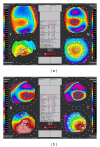Achondroplasia associated with bilateral keratoconus
- PMID: 23259098
- PMCID: PMC3521417
- DOI: 10.1155/2012/573045
Achondroplasia associated with bilateral keratoconus
Abstract
We report a rare case of bilateral keratoconus in association with achondroplasia. A 26-year-old male, with a known case of achondroplasia, complained of bilateral gradual deterioration in vision for the past few years. Slit lamp biomicroscopy showed bilateral central corneal protrusion and stromal thinning at the apex consistent with keratoconus. a trial of hard contact lens fitting failed to improve VA in the left eye (LE). Right eye (RE) improved to 20/25. The patient underwent penetrating keratoplasty (PKP) in his LE. Twenty-seven months postoperatively, uncorrected visual acuity (UCVA) was 20/30. Ophthalmologists should be aware that patients with achondroplasia who complain of poor vision should be suspected of having keratoconus once other more common conditions are ruled out.
Figures
Similar articles
-
Collagen cross-linking using riboflavin and ultraviolet-a for corneal thinning disorders: an evidence-based analysis.Ont Health Technol Assess Ser. 2011;11(5):1-89. Epub 2011 Nov 1. Ont Health Technol Assess Ser. 2011. PMID: 23074417 Free PMC article.
-
Intrastromal corneal ring implants for corneal thinning disorders: an evidence-based analysis.Ont Health Technol Assess Ser. 2009;9(1):1-90. Epub 2009 Apr 1. Ont Health Technol Assess Ser. 2009. PMID: 23074513 Free PMC article.
-
Concurrent macular corneal dystrophy and keratoconus.Middle East Afr J Ophthalmol. 2012 Apr-Jun;19(2):251-3. doi: 10.4103/0974-9233.95266. Middle East Afr J Ophthalmol. 2012. PMID: 22623870 Free PMC article.
-
Late occurrence of granular dystrophy in bilateral keratoconus: penetrating keratoplasty and long-term follow-up.Indian J Ophthalmol. 2011 Sep-Oct;59(5):398-400. doi: 10.4103/0301-4738.83624. Indian J Ophthalmol. 2011. PMID: 21836353 Free PMC article.
-
Toric IOL implantation in a patient with keratoconus and previous penetrating keratoplasty: a case report and review of literature.BMC Ophthalmol. 2018 Aug 29;18(1):215. doi: 10.1186/s12886-018-0895-y. BMC Ophthalmol. 2018. PMID: 30157798 Free PMC article. Review.
Cited by
-
Subluxated cataractous lens and high myopia: An uncommon association in an achondroplasia child.Oman J Ophthalmol. 2023 Oct 18;16(3):537-540. doi: 10.4103/ojo.ojo_42_23. eCollection 2023 Sep-Dec. Oman J Ophthalmol. 2023. PMID: 38059098 Free PMC article.
References
-
- Shirley ED, Ain MC. Achondroplasia: manifestations and treatment. Journal of the American Academy of Orthopaedic Surgeons. 2009;17(4):231–241. - PubMed
-
- Weiss AH, Kousseff BG, Ross EA, Longbottom J. Simple microphthalmos. Archives of Ophthalmology. 1989;107(11):1625–1630. - PubMed
-
- Meyers GA, Orlow SJ, Munro IR, Przylepa KA, Jabs EW. Fibroblast growth factor receptor 3 (FGFR3) transmembrane mutation in Crouzon syndrome with acanthosis nigricans. Nature Genetics. 1995;11(4):462–464. - PubMed
-
- Rosenthal AR, Ryan SJ, Horowitz P. Ocular manifestations of dwarfism. Transactions of American Academy of Ophthalmology and Otolaryngology. 1972;76(6):1500–1518. - PubMed
-
- Guirgis MF, Thornton SS, Tychsen L, Lueder GT. Cone-rod retinal dystrophy and Duane retraction syndrome in a patient with achondroplasia. Journal of American Association for Pediatric Ophthalmology and Strabismus. 2002;6(6):400–401. - PubMed
LinkOut - more resources
Full Text Sources
Miscellaneous




